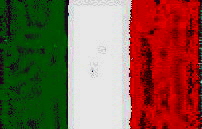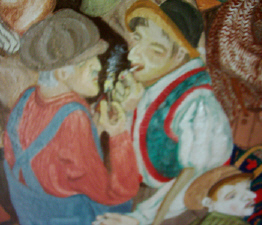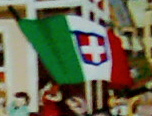Modern Italian history and the flags.
 Prior to 1860, Italy was a group of separately governed states, because these states had a long history of disagreement and conflict between themselves, they became easily divided and conquered ultimately being ruled by Princes, Kings, and Emperors from France, Spain, Austria and many other foreign countries.
Prior to 1860, Italy was a group of separately governed states, because these states had a long history of disagreement and conflict between themselves, they became easily divided and conquered ultimately being ruled by Princes, Kings, and Emperors from France, Spain, Austria and many other foreign countries.
The northern states were particularly vulnerable, being bordered by France in the west, and Austria in the east. When Napoleon advanced into Italy, devastating the land and the population, the tremendous hardship and
Napoleonic codes imposed on all of the states broke down the age-old hostilities between states producing renewed calls for unification of the seperate states into one country.
Britain herself trying to stem Naploeon's advancement in Europe, and together with Austria for their own political purpose, fueled the revolutionary fervour of a unified Italy.
Historical background to the Flags.
To trace the history of the Italian flag, is also to discover the last three centuries of Italian history.
The flag of Italy that we recognise today with it's Green, White and Red vertical stripes first appeared at a student demonstration in Bologna in May of 1795.These three colours, ( Dante first used them to represent the three cardinal virtues of Faith, Hope and Charity - and many other catholic countries have incorporated them into their national flags), had been very popular with the Northern States of Italy for several hundreds of years, and these states were the first to officially adopt the colours to represent themselves after Napoleon's army crossed Italy.
After the Battle of Lodi, in May 1796, the French general Napoleon Bonaparte proceeded to organize two states—one north of the Po River, the Transpadane Republic and the Cispadane Republic south of the Po River.
 The Transpadane Republic formed in 1796 and was mainly comprised of the rich state of Lombardy, and used the oblong vertical Italian tricolour flag.
The Transpadane Republic formed in 1796 and was mainly comprised of the rich state of Lombardy, and used the oblong vertical Italian tricolour flag.
 The Cispadane Republic (Italian: Repubblica Cispadana) was formed on 16 October 1796, by representatives from the provinces of Modena, Bologna, Ferrara and Reggio Emilia at a congress unofficially organized by Napoleon Bonaparte
who needed to regroup and expand his troops in Italy against Austria. The newly formed the Repubblica Cispadana, invited other Italian populations to join them.
By January 1797 a civic guard and government had been formed, represented by a a horizontal tricolour flag, with red (top), white and green stripes;, in the middle, an
emblem composed of a quiver and four arrows ( war trophy symbol) that represented the four provinces forming the Republic, all within a crown of bay leaves (laurel).
The Cispadane Republic (Italian: Repubblica Cispadana) was formed on 16 October 1796, by representatives from the provinces of Modena, Bologna, Ferrara and Reggio Emilia at a congress unofficially organized by Napoleon Bonaparte
who needed to regroup and expand his troops in Italy against Austria. The newly formed the Repubblica Cispadana, invited other Italian populations to join them.
By January 1797 a civic guard and government had been formed, represented by a a horizontal tricolour flag, with red (top), white and green stripes;, in the middle, an
emblem composed of a quiver and four arrows ( war trophy symbol) that represented the four provinces forming the Republic, all within a crown of bay leaves (laurel).
The new republic lasted only until June 29, 1797, when along with The Transpadane Republic and the province of Novara it was were merged into the Cisalpine Republic, with Milan as the new capital.
Austria acknowledged the new Republic in the Treaty of Campoformio of October 17, 1797, gaining in exchange what remained of the Venetian Republic.
The Cisalpine Republic (this northern region had been called Gallia Cisalpina by the Romans) consisted of roughly the former Duchy of Milan, those portions of the Republic of Venice west of the Adige River, the Duchy of Modena, the Papal Legations, and the Piedmontese province of Novara.
Milan was the capital city with a prosperous economy based on agriculture and a flourishing silk industry.
 The flag of the Cisalpine Republic was the Transpadane Republic vertical Italian tricolour, with the square shape of the Cispadane Republic flag, this flag rallied the troops sent into battle against Napoleon in Lombardy.
The flag of the Cisalpine Republic was the Transpadane Republic vertical Italian tricolour, with the square shape of the Cispadane Republic flag, this flag rallied the troops sent into battle against Napoleon in Lombardy.
The Cisalpine Republic (Italian: Repubblica Cisalpina) established as a French client republic in Northern Italy only lasted from 1797 to 1802.
This square version of the flag with vertical Italian tricolours was then used by Napoleon for his new Kingdom of Italy in 1805, but with his downfall from power Italy disintegrated as one country, the flag fell out of use.

 The unification of Italy became a reality in 1870 during a period called the 'Risorgimento' (Revival),
brought about by Revolutionaries led by Genoan Scholar Giuseppe Mazzini (1805-72) and Giuseppe Garibaldi (1807-82). In 1860, Guiseppe Garibaldi returned from Latin America and rallied an army of volunteers to drive out foreign rulers.
This army became known as the red shirts which became their symbolic uniform, they took over all of the states except Rome and Venetia, after nine years these too became part of Italy.
The unification of Italy became a reality in 1870 during a period called the 'Risorgimento' (Revival),
brought about by Revolutionaries led by Genoan Scholar Giuseppe Mazzini (1805-72) and Giuseppe Garibaldi (1807-82). In 1860, Guiseppe Garibaldi returned from Latin America and rallied an army of volunteers to drive out foreign rulers.
This army became known as the red shirts which became their symbolic uniform, they took over all of the states except Rome and Venetia, after nine years these too became part of Italy.
For more information on Garibaldi and his 'Red Shirts' visit the following site
(which includes a list of the volunteers)http://www.italian-american.com/garibal.htm
There is a large print children's site at:http://www.kidcyber.com.au/topics/italyhist.htm
The King of Sardinia, Charles Alberta resurrected the flag and when his son Victor Emmanual ll became the first King of the Italy in 1861, having made peace with Austria and re-gaining Lombardy, Rome and Venetia would unite with the rest of Italy into one kingdom in 1870.
Visit the following site for more on Victor Emmanualhttp://www.ohiou.edu/~chastain/rz/victorem.htm

The shield - the official Arms of the Royal House of Savoy was placed in the centre white stripe, of the vertical tri-coloured traditional flag which became the official emblem of the Entire country. It is this the flag (there is one on display in The Colombo Lodge Archives in Trail) that most of the Italian emmigrants took with them from 1860 to 1914, the first major period of Italian Emigration.
By 1900, Italy, with Rome as the capital, was only 30 years old as a nation, with little direction as to where it was going economically, socially and politically.
During the first world war, Italy joined with Britain and France to combat Germany.
After the war was over in 1918, many Italians were poorer than ever and without means to make a living.
With mounting economical and political unrest the stage was set for change, and the fascists under the leadership of Benito Mussolini
promised the people better things, marching on Rome in 1922 and seizing power from the King.
From 1940 to 1943, during the second world war, Italy under Mussolini (and his blackshirts) fought on the side of the Germans. After his defeat, the King was returned to rule, a referendum was held, and the people voted in favour of a republic with a president.

After the turmoil and political divisions of World Wars I and II,
the original three striped flag - "Il Tricolore" with an heraldic 2h:3w ratio, was reinstated by most citizens of Italia as the 'official flag'.
Italy after 1945
The referendum results bringing about the new Italian republic were heavily contested, the desperate fascist Salo Republic attempt was quickly crushed by the Allies in April 1945.
The 1947 peace treaty, involved making minor adjustments to Italy's frontier with France, the eastern border area was transferred to Yugoslavia, and the area around Trieste was designated a free territory.
A new constitution for the new republic of Italy, took effect on January 1, 1948. In the 1950's Italy became a member of the NATO alliance and an ally of the United States, which helped to revive the Italian economy through the Marshall Plan.
The years following the war until present day, have been volatile politically, with parties of a wide spectrum of political leanings seeking to be democratically elected governments.
Today Italy is a charter member of NATO and the European Union. It joined the growing political and economic unification of Western Europe, including the introduction of the Euro in 1999.
Further reading and sources:
W. J. Stillman. The Union of Italy - 1815-1895. C U Press.
D.M.Smith. Italy and it's Monarchy. New Haven.1989.
More on Italian History for kids at:http://cybersleuth-kids.com/sleuth/History/Ancient_Civilizations/Rome/index.htm
Maps: Courtesy of Wikipedia and University of Texas.
 Prior to 1860, Italy was a group of separately governed states, because these states had a long history of disagreement and conflict between themselves, they became easily divided and conquered ultimately being ruled by Princes, Kings, and Emperors from France, Spain, Austria and many other foreign countries.
Prior to 1860, Italy was a group of separately governed states, because these states had a long history of disagreement and conflict between themselves, they became easily divided and conquered ultimately being ruled by Princes, Kings, and Emperors from France, Spain, Austria and many other foreign countries. The Transpadane Republic formed in 1796 and was mainly comprised of the rich state of Lombardy, and used the oblong vertical Italian tricolour flag.
The Transpadane Republic formed in 1796 and was mainly comprised of the rich state of Lombardy, and used the oblong vertical Italian tricolour flag. The Cispadane Republic (Italian: Repubblica Cispadana) was formed on 16 October 1796, by representatives from the provinces of Modena, Bologna, Ferrara and Reggio Emilia at a congress unofficially organized by Napoleon Bonaparte
who needed to regroup and expand his troops in Italy against Austria. The newly formed the Repubblica Cispadana, invited other Italian populations to join them.
By January 1797 a civic guard and government had been formed, represented by a a horizontal tricolour flag, with red (top), white and green stripes;, in the middle, an
emblem composed of a quiver and four arrows ( war trophy symbol) that represented the four provinces forming the Republic, all within a crown of bay leaves (laurel).
The Cispadane Republic (Italian: Repubblica Cispadana) was formed on 16 October 1796, by representatives from the provinces of Modena, Bologna, Ferrara and Reggio Emilia at a congress unofficially organized by Napoleon Bonaparte
who needed to regroup and expand his troops in Italy against Austria. The newly formed the Repubblica Cispadana, invited other Italian populations to join them.
By January 1797 a civic guard and government had been formed, represented by a a horizontal tricolour flag, with red (top), white and green stripes;, in the middle, an
emblem composed of a quiver and four arrows ( war trophy symbol) that represented the four provinces forming the Republic, all within a crown of bay leaves (laurel). The flag of the Cisalpine Republic was the Transpadane Republic vertical Italian tricolour, with the square shape of the Cispadane Republic flag, this flag rallied the troops sent into battle against Napoleon in Lombardy.
The flag of the Cisalpine Republic was the Transpadane Republic vertical Italian tricolour, with the square shape of the Cispadane Republic flag, this flag rallied the troops sent into battle against Napoleon in Lombardy.
 The unification of Italy became a reality in 1870 during a period called the 'Risorgimento' (Revival),
brought about by Revolutionaries led by Genoan Scholar Giuseppe Mazzini (1805-72) and Giuseppe Garibaldi (1807-82). In 1860, Guiseppe Garibaldi returned from Latin America and rallied an army of volunteers to drive out foreign rulers.
This army became known as the red shirts which became their symbolic uniform, they took over all of the states except Rome and Venetia, after nine years these too became part of Italy.
The unification of Italy became a reality in 1870 during a period called the 'Risorgimento' (Revival),
brought about by Revolutionaries led by Genoan Scholar Giuseppe Mazzini (1805-72) and Giuseppe Garibaldi (1807-82). In 1860, Guiseppe Garibaldi returned from Latin America and rallied an army of volunteers to drive out foreign rulers.
This army became known as the red shirts which became their symbolic uniform, they took over all of the states except Rome and Venetia, after nine years these too became part of Italy.
